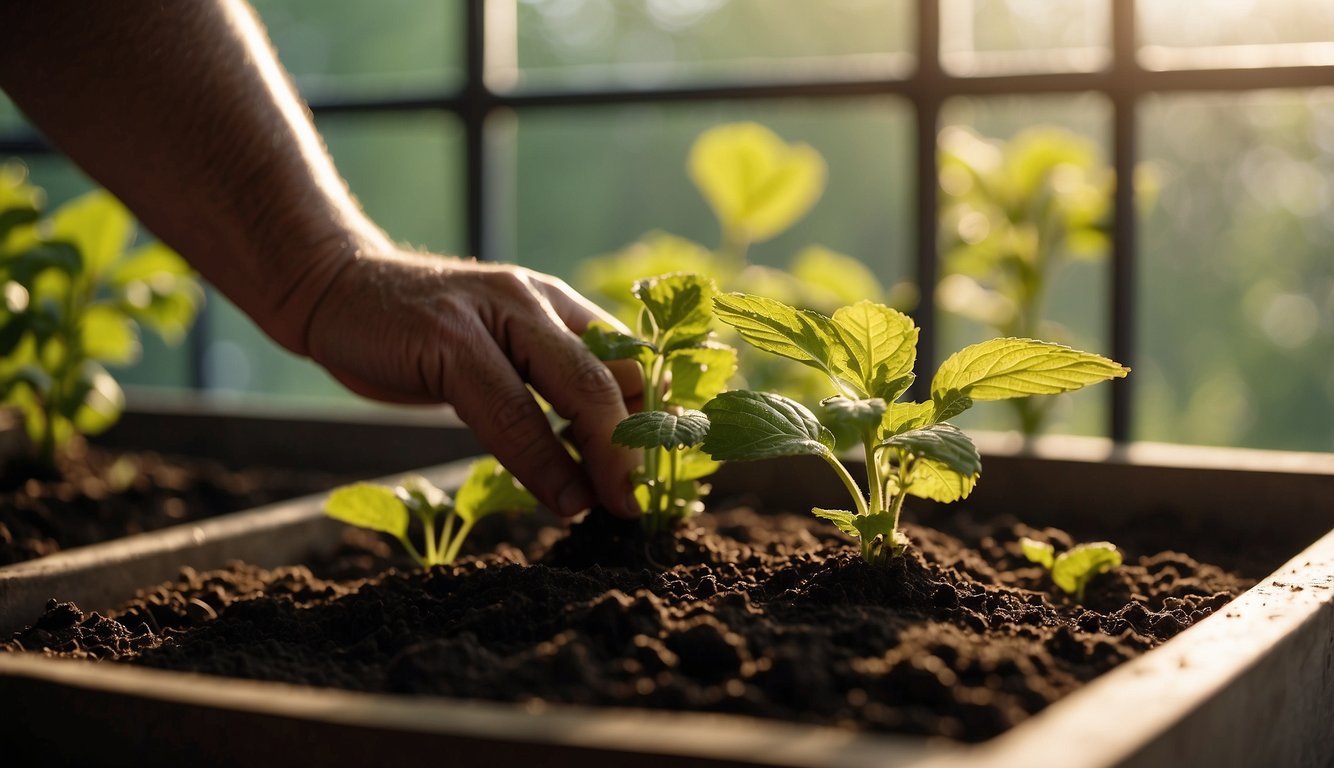Planting mint from cuttings is a simple and rewarding way to propagate new mint plants. Mint is a versatile herb, perfect for various dishes and drinks. It’s a popular choice for home gardeners. By taking cuttings from an existing mint plant, you can grow new plants that are genetically identical to the parent plant.
To start, choose a healthy mint plant to take cuttings from. It’s best to take cuttings in the spring or early summer, when the plant is actively growing. Use sharp, clean scissors to cut a stem that is 3-4 inches long, making sure to cut just below a node where the leaves attach to the stem. Remove the lower leaves from the stem, leaving only a few leaves at the top.
Once you have your cuttings, you can root them in water or soil. Both methods are easy and effective, and it’s up to personal preference which one you choose. With a little patience and care, your mint cuttings will quickly grow roots and develop into healthy new plants.
Understanding Mint Cuttings
As a gardening enthusiast, I have found that propagating mint from cuttings is an easy and rewarding process. Mint cuttings are sections of a healthy mint stem that are removed from the parent plant and used to propagate new plants. In this section, I will discuss the types of mint that are suitable for cuttings and the benefits of propagating mint.
Types of Mint for Cuttings
Mint is a hardy and versatile herb that comes in many different varieties. Some of the most popular types of mint for cuttings include peppermint, spearmint, chocolate mint, and pineapple mint. Each variety has its own unique flavor and aroma, making it a great addition to any herb garden.
When selecting mint plants for cuttings, it is important to choose healthy and disease-free plants. Look for plants that have strong stems and lush foliage, as these are signs of a healthy plant. Avoid plants that are wilted or have yellowing leaves, as these are signs of a sickly plant.
Benefits of Propagating Mint
Propagating mint from cuttings is an easy and cost-effective way to expand your herb garden. Mint is a fast-growing plant that is easy to propagate, making it an ideal choice for beginners. By propagating your own mint plants, you can ensure that they are healthy and free from pesticides and other chemicals.
In addition to being easy to grow, mint has many health benefits. Mint contains antioxidants and has anti-inflammatory properties, making it a great choice for people with digestive issues or respiratory problems. Mint can also be used to flavor food and drinks, making it a versatile addition to any kitchen.
Understanding mint cuttings is essential for anyone interested in propagating their own mint plants. By selecting the right types of mint and using proper propagation techniques, you can create a thriving herb garden that will provide you with fresh, healthy mint for years to come.
Preparation for Planting

Selecting Healthy Mint Stems – Planting Mint from Cuttings
Before planting mint from cuttings, it is important to select healthy stems. Choose a stem that is green, plump, and free from any signs of disease or damage. Avoid stems that are wilted, yellow, or have brown spots. Healthy stems will have a higher chance of growing roots and developing into a healthy plant.
Tools and Materials Needed
To plant mint from cuttings, you will need the following tools and materials:
- Pruning shears or sharp scissors
- Container
- Potting soil or potting mix
- Rooting hormone
Pruning shears or sharp scissors are necessary to cut the stem from the parent plant. A container is needed to hold the potting soil or mix and the cutting. Potting soil or mix is essential to provide the cutting with the necessary nutrients to grow. Rooting hormone is optional but can increase the chances of successful root growth.
When selecting a container, choose one that is the appropriate size for the cutting. The container should be deep enough to accommodate the length of the cutting and wide enough to allow for root growth. It is important to use potting soil or mix specifically formulated for container gardening as it is designed to provide the necessary nutrients and drainage for the plant.
Selecting healthy mint stems and having the necessary tools and materials are crucial for successfully planting mint from cuttings.
Rooting Mint Cuttings – Planting Mint from Cuttings
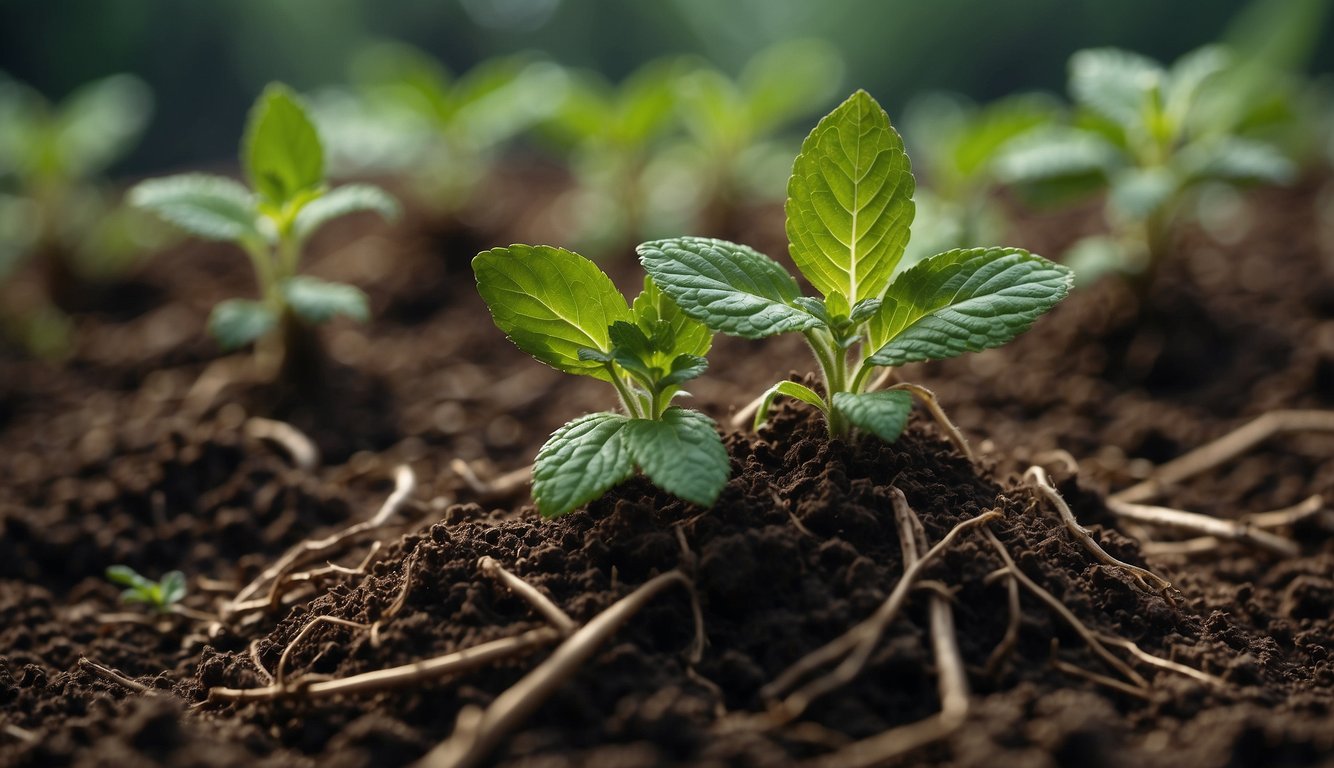
When it comes to propagating mint plants, rooting cuttings is a quick and easy method to get new plants. You can root mint cuttings can be done in two ways: rooting in water and rooting in soil.
Rooting in Water
Rooting mint cuttings in water is a popular method because it is simple and requires minimal effort. To root mint cuttings in water, follow these steps:
- Cut a 3-4 inch stem from a healthy mint plant just below a node or leaf node using a sharp, clean pair of scissors or pruning shears.
- Remove the lower leaves from the stem, leaving only a few leaves at the top.
- Place the stem in a jar or glass jar filled with water, making sure that the stem is submerged and the leaves are above the waterline.
- Put the jar in a bright, indirect light location, such as a windowsill, and avoid direct sunlight.
- Change the water every few days to keep it fresh and prevent the growth of bacteria.
- After a few weeks, the stem should develop roots. Once the roots are at least an inch long, you can transplant the mint cutting into soil.
Rooting in Soil – Planting Mint from Cuttings
Rooting mint cuttings in soil is another popular method that produces healthy and strong plants. To root mint cuttings in soil, follow these steps:
- Cut a 3-4 inch stem from a healthy mint plant just below a node or leaf node using a sharp, clean pair of scissors or pruning shears.
- Remove the lower leaves from the stem, leaving only a few leaves at the top.
- Dip the cut end of the stem in rooting hormone to encourage root growth.
- Plant the stem in moist soil or compost, making sure that the soil covers the node where the leaves were removed.
- Place the pot in a warm, bright location, but avoid direct sunlight.
- Water the soil regularly to keep it moist, but avoid overwatering.
- After a few weeks, the stem should develop roots and new leaves. Once the roots are at least an inch long, you can transplant the mint cutting into a larger pot or into your garden.
Rooting mint cuttings is an easy and rewarding way to propagate new plants. Whether you choose to root your mint cuttings in water or soil, both methods can produce healthy and strong plants with a well-developed root system.
Transplanting Mint Cuttings – Planting Mint from Cuttings
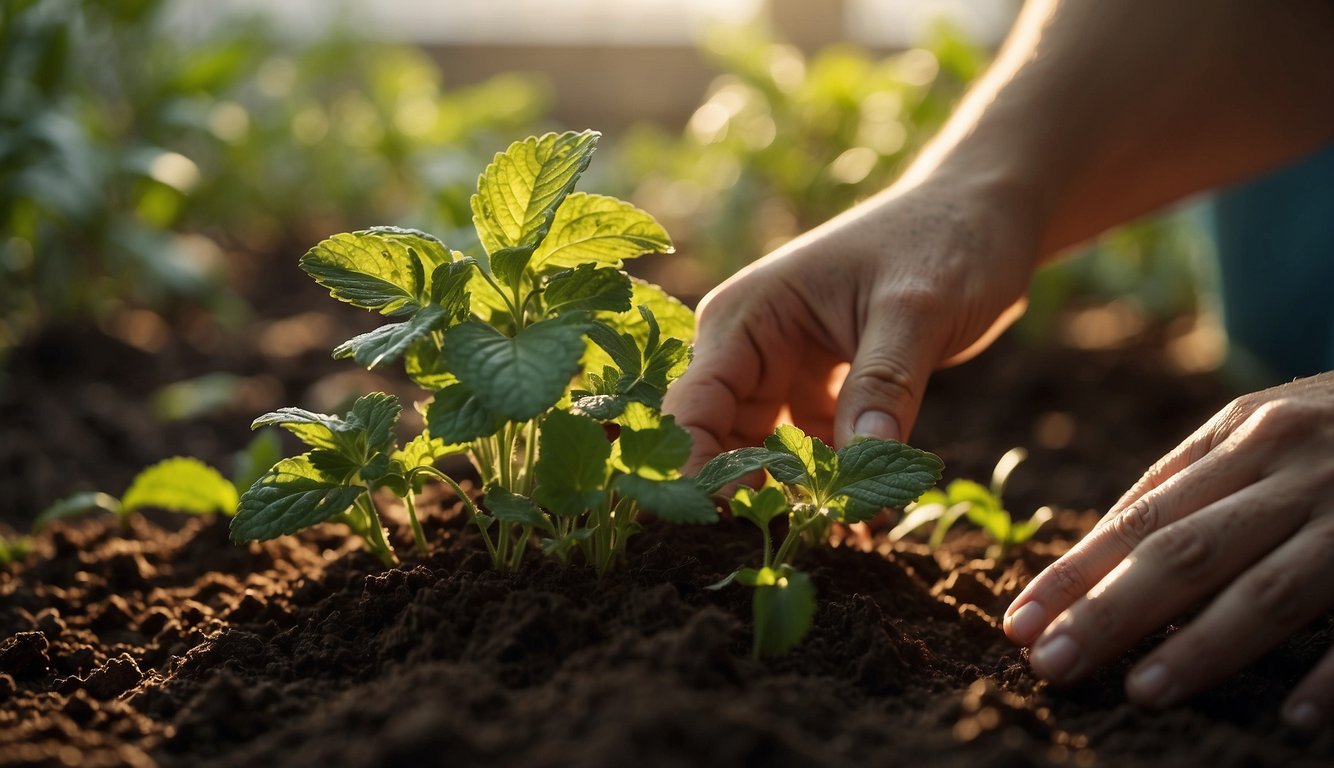
Transplanting mint cuttings is an essential step in propagating mint from cuttings. It is important to transplant the cuttings at the right time and in the right way to ensure that they grow into healthy plants. In this section, I will explain when to transplant mint cuttings and how to transplant them to pots or the garden.
When to Transplant – Planting Mint from Cuttings
The best time to transplant mint cuttings is when they have developed new growth and have established roots. This usually takes around 3-4 weeks. You can check if the cuttings have developed roots by gently tugging on them. If you feel resistance, it means that the roots have started to grow.
It is important to avoid transplanting the mint cuttings too early as they may not have developed enough roots to anchor themselves in the soil. This can cause transplant shock, which can stunt the growth of the plant or even kill it.
Transplanting to Pots or Garden
When transplanting mint cuttings, you can either plant them in pots or directly in the garden. If you choose to plant them in pots, make sure that the pots have drainage holes to prevent water from accumulating in the soil. This can cause root rot, which can kill the plant.
If you are using small pots, you may need to transplant the mint cuttings again as they grow. Mint is a fast-growing plant and can quickly outgrow small pots. When transplanting to larger pots, make sure to use a high-quality potting mix that is rich in nutrients.
If you are transplanting the mint cuttings to the garden, make sure to choose a location that gets plenty of sunlight and has well-draining soil. Mint prefers moist soil but can’t tolerate waterlogged soil.
Transplanting mint cuttings is an important step in propagating mint from cuttings. Make sure to transplant the cuttings at the right time and in the right way to ensure that they grow into healthy plants.
Caring for New Mint Plants – Planting Mint from Cuttings

After successfully propagating mint from cuttings, it’s important to provide the necessary care to ensure that the new plants thrive. Here are some tips on how to care for new mint plants.
Watering and Feeding
Mint plants require consistent moisture to grow properly. Water the plants regularly, but make sure not to overwater them as this can lead to root rot. A good rule of thumb is to water the plants when the top inch of soil feels dry to the touch.
In terms of feeding, mint plants benefit from natural fertilizers such as fish emulsion or compost tea. Apply the fertilizer every few weeks during the growing season to promote healthy growth.
Light and Temperature Requirements – Planting Mint from Cuttings
Mint plants prefer bright but indirect light. They can tolerate some direct sunlight, but too much can cause the leaves to wilt and burn. If growing mint indoors, place the plants near a sunny window that receives morning or afternoon sun.
Mint plants are also sensitive to extreme temperatures. They prefer temperatures between 65-70°F (18-21°C) during the day and slightly cooler temperatures at night. Avoid placing the plants near drafty windows or air conditioning vents.
Pruning and Maintenance
Pruning is essential for maintaining healthy and bushy mint plants. Pinch off the tips of the stems regularly to encourage new growth and prevent the plants from becoming too leggy.
Mint plants are also susceptible to pests and diseases such as spider mites and powdery mildew. Keep an eye out for any signs of infestation and treat them promptly with an organic insecticide or fungicide.
Finally, be patient with new mint plants as they establish new roots and acclimate to their new environment. With proper care and maintenance, your mint plants will thrive and provide you with fresh herbs for years to come.
Troubleshooting Common Issues
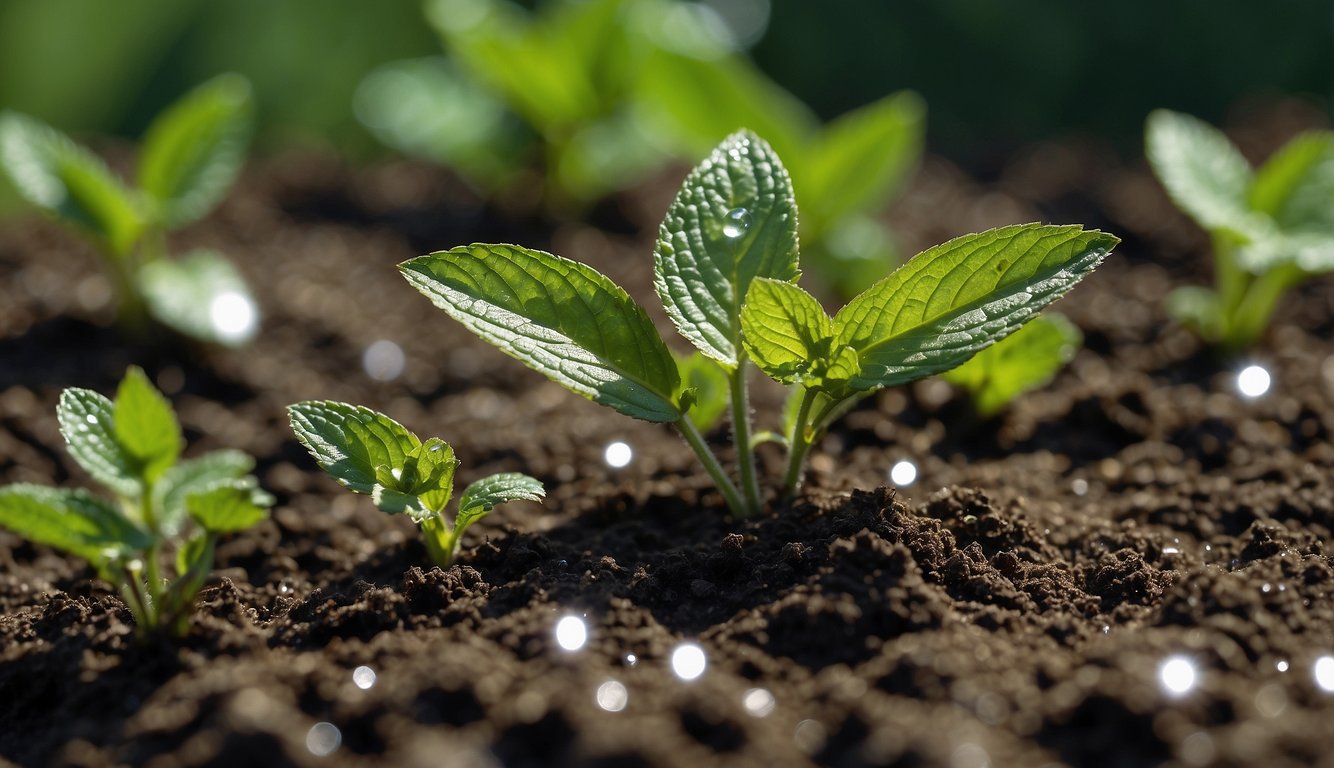
Growing mint from cuttings is a relatively easy process, but problems can still arise. In this section, I will discuss some common issues that you may encounter when propagating mint from cuttings and provide some solutions to help you troubleshoot them.
Dealing with Pests and Diseases – Planting Mint from Cuttings
Mint is generally a hardy plant, but it can still fall victim to pests and diseases. One common problem is mint rust, a fungal disease that causes orange or yellow spots on the leaves. If you notice these spots, it is important to remove the affected leaves and dispose of them properly to prevent the disease from spreading. You can also try spraying the plant with a fungicide to help control the spread of the disease.
Another common pest that can affect mint is the spider mite. These tiny pests can cause yellowing and wilting of the leaves. To get rid of spider mites, you can try spraying the plant with a mixture of water and dish soap. You can also introduce natural predators like ladybugs to the area to help control the population of spider mites.
Addressing Poor Growth
If you notice that your mint cuttings are not growing as well as they should be, there may be a few things that you can do to help them along. One common issue is that the stems are not healthy enough to support new growth. When selecting cuttings, it is important to choose stems that are firm and healthy-looking. You should also make sure that the cuttings are not too long, as this can make it difficult for the plant to establish a strong root system.
Another common issue is that the soil is not providing the plant with the nutrients that it needs. Mint prefers a well-draining soil that is rich in organic matter. If you are having trouble with poor growth, you may want to consider adding some compost or other organic matter to the soil to help improve its quality.
Overall, growing mint from cuttings is a relatively easy process that can be done with a little bit of patience and care. By following the tips and suggestions outlined in this section, you should be able to troubleshoot any issues that may arise and enjoy a healthy and thriving mint plant in no time.
Harvesting and Using Mint – Planting Mint from Cuttings
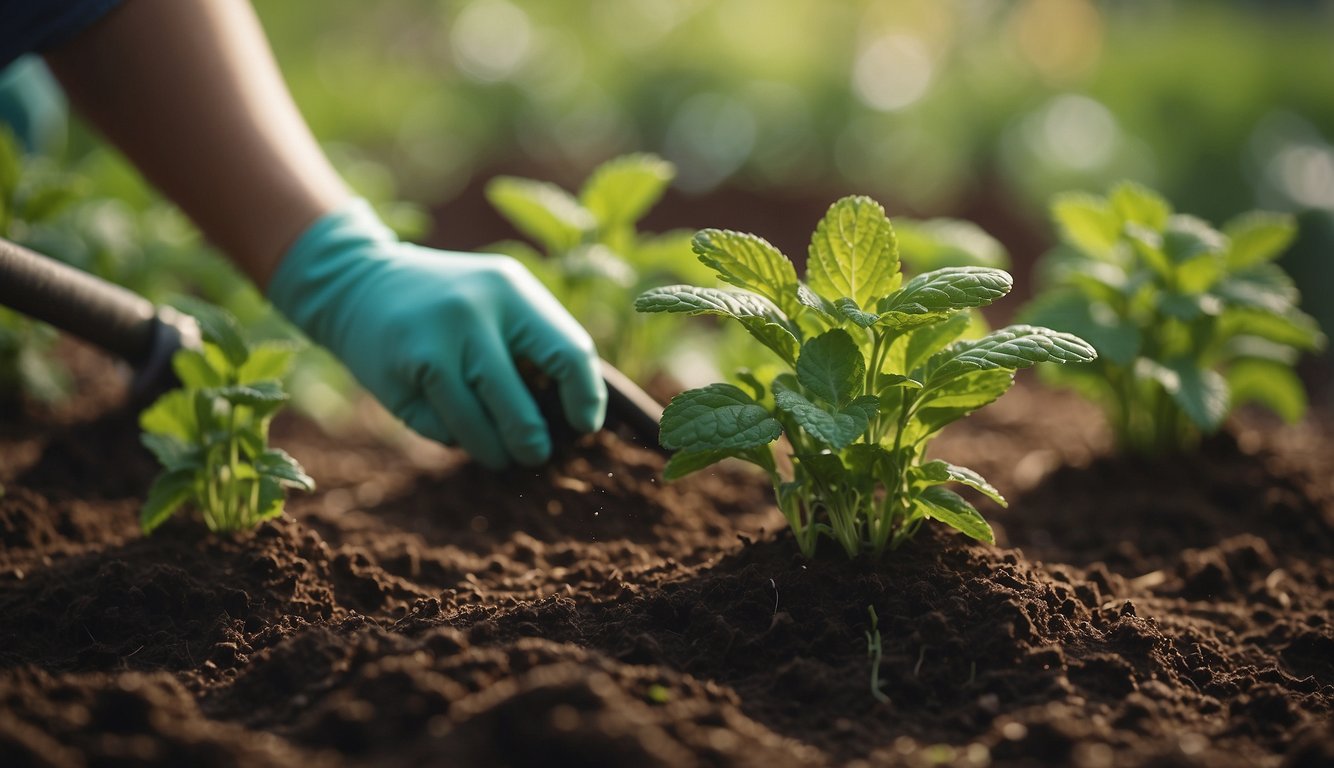
Mint is a versatile herb that can be used in a variety of culinary and medicinal applications. It is easy to grow and propagate, making it a popular choice for herb gardens. Here are some tips on harvesting and using mint.
Harvesting Tips – Planting Mint from Cuttings
When harvesting mint, it is best to do so in the morning when the oils in the leaves are most concentrated. Simply cut the stems just above a set of leaves, leaving a few inches of stem attached. This will encourage new growth and help keep the plant healthy.
Mint can be harvested throughout the growing season, but it is best to avoid harvesting more than one-third of the plant at a time. This will allow the plant to recover and continue to produce new growth.
Culinary and Medicinal Uses
Mint is a popular herb for culinary use, adding a bright, fresh flavor to a variety of dishes. It is commonly used in salads, drinks, and desserts. Chocolate mint, peppermint, and spearmint are all popular varieties of mint that can be used in different ways.
Mint also has a long history of medicinal use. It is commonly used to soothe upset stomachs, relieve headaches, and freshen breath. It can be consumed in tea form or added to other herbal remedies.
In my eBook on herb gardening, I go into more detail on the various culinary and medicinal uses of mint, as well as how to grow and propagate it. Overall, mint is a versatile and easy-to-grow herb that can add flavor and health benefits to your life.
Seasonal Considerations – Planting Mint from Cuttings
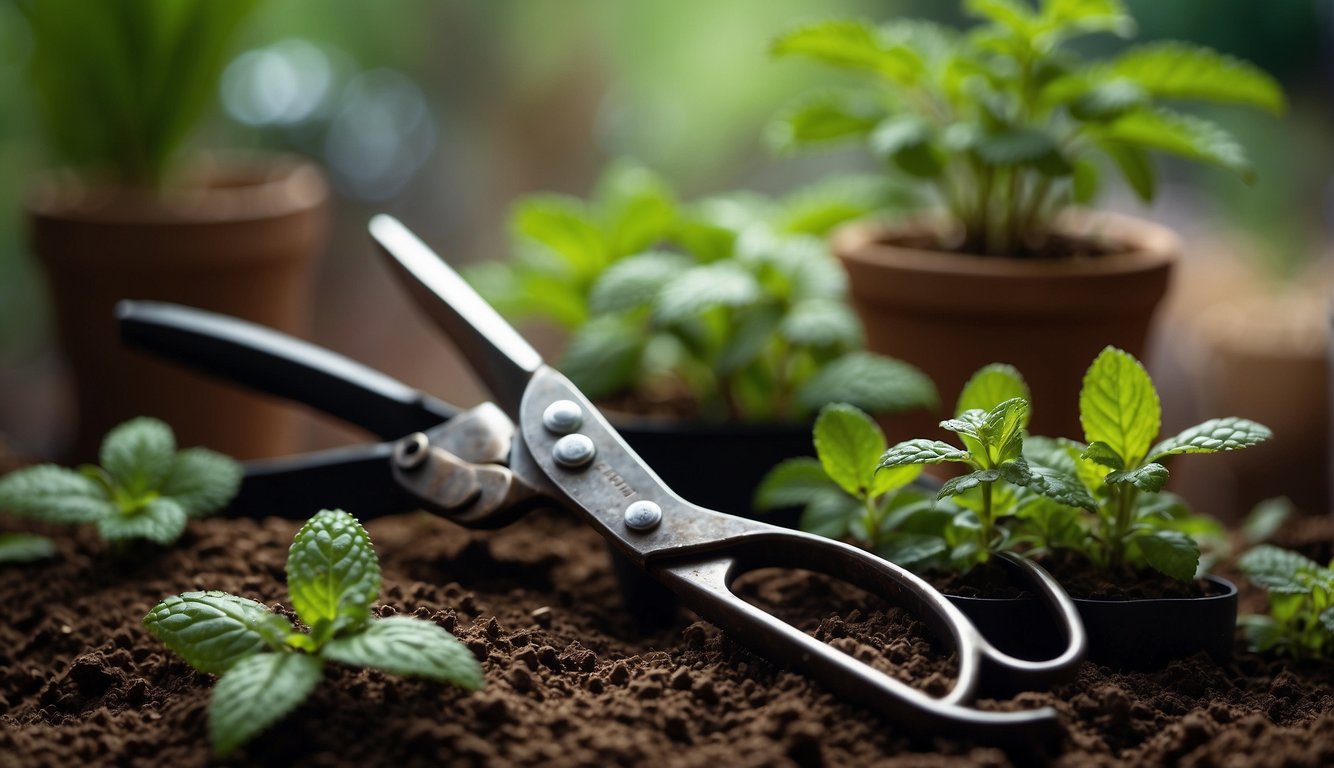
As with any plant, there are specific seasonal considerations to keep in mind when planting mint from cuttings. Here are a few things to keep in mind:
Best Time to Take Cuttings – Planting Mint from Cuttings
The ideal time to take cuttings from your mint plant is in late spring or early summer, when the plant is in full growth and before it begins to bloom. At this time, the plant is healthy and free of pests and disease, making it more likely that your cuttings will take root and grow successfully.
To take cuttings, use a pair of sharp scissors to snip off a stem that is about 4-6 inches long. Make sure to cut just below a node, which is where the leaves attach to the stem. Remove the leaves from the bottom half of the stem, and dip the cut end in rooting hormone. Then, plant the stem in a pot filled with moist potting soil.
Winter Care for Mint
Mint is a hardy plant that can survive cold temperatures, but it does require some care during the winter months. If you live in a region with harsh winters, it is best to bring your mint plant indoors before the first frost.
To prepare your mint plant for winter, cut it back to about 1 inch above the soil line. Then, water the plant thoroughly and place it in a sunny window. Make sure to keep the soil moist, but not waterlogged.
During the winter months, your mint plant will go dormant and stop growing. However, it will still require some care to ensure that it stays healthy. Make sure to check the soil regularly and water the plant as needed. If you notice any signs of pests or disease, take action immediately to prevent the problem from spreading.
By following these seasonal considerations, you can ensure that your mint plant thrives and produces delicious leaves for you to use in your cooking and other projects.
Planting Mint from Cuttings
Let’s dive into the refreshing world of planting mint from cuttings!
Firstly, we have the cutting. Choose a healthy, vigorous mint stem, and make a clean cut. It’s your first step to minty goodness!
Next, let’s talk about water. Place your cutting in a glass of water. In no time, you’ll see roots sprouting. It’s nature’s magic!
Ever heard of transplanting? Once your cutting has roots, it’s ready for soil. Plant it, water it, and watch it grow!
And let’s not forget care. Mint loves sun and water. Give it plenty, and it’ll reward you with lush growth.
Remember, folks, every plant has its needs. So, let’s keep planting, keep nurturing, and keep enjoying the refreshing aroma of our mint plants!
For more minty wisdom, don’t forget to visit my homepage at theherbprof.com. Keep those green thumbs up!
References – Planting Mint from Cuttings
Little Herb Encyclopedia, by Jack Ritchason; N.D., Woodland Publishing Incorporated, 1995
The Ultimate Healing System, Course Manual, Copyright 1985, Don Lepore
Planetary Herbology, Michael Tierra, C.A., N.D., Lotus Press, 1988
Handbook of Medicinal Herbs, by James A. Duke, Pub. CRP Second Edition 2007
The Complete Medicinal Herbal, by Penelope Ody, Published by Dorling Kindersley
Check the Following Articles!
Bee Water Dish: Providing Essential Hydration
Do Cucumbers Need Trellis? Growing Cucumbers Vertically
Coffee Compost: Turning Your Used Grounds into Rich Soil
Frequently Asked Questions – Planting Mint from Cuttings
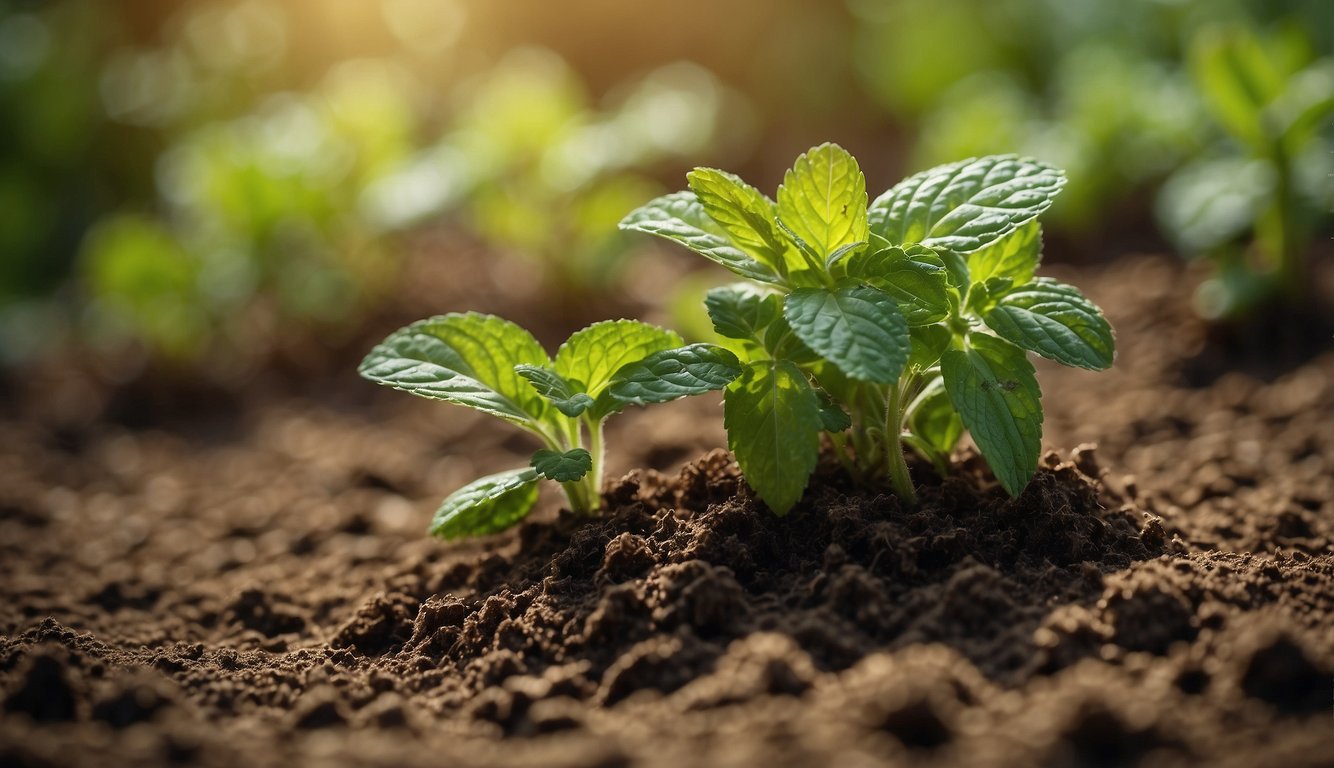
What is the best method to root mint cuttings in water?
The best method to root mint cuttings in water is to take a healthy stem cutting of about 3 to 4 inches long, with green leaves, and submerge the bottom 2 inches of the cutting in water. Place the cutting in a sunny spot for 1-2 weeks to grow. You can also add a rooting hormone to encourage root growth, although it is not necessary. Once the roots reach about an inch long, you can transplant the cutting into soil.
How can you successfully grow mint indoors from cuttings?
To successfully grow mint indoors from cuttings, you will need a healthy stem cutting of about 3 to 4 inches long, with green leaves. Plant the cutting in moist soil and keep it in a warm, humid location until roots form. Once the roots are established, you can move the plant to a bright location with indirect sunlight. Keep the soil moist but not waterlogged, and fertilize the plant every two weeks with a balanced fertilizer.
What are the necessary steps to propagate mint from store-bought stems?
To propagate mint from store-bought stems, you will need to take a healthy stem cutting of about 3 to 4 inches long, with green leaves. Remove the leaves from the bottom 2 inches of the stem, and dip the cut end in rooting hormone. Plant the cutting in moist soil and keep it in a warm, humid location until roots form. Once the roots are established, you can move the plant to a bright location with indirect sunlight. Keep the soil moist but not waterlogged, and fertilize the plant every two weeks with a balanced fertilizer.
Why might mint cuttings fail to root in water and how can this be remedied?
Mint cuttings may fail to root in water if the stem is not healthy, or if the water is not changed frequently enough. To remedy this, make sure you take a healthy stem cutting, and change the water every few days to keep it fresh. You can also add a small amount of rooting hormone to the water to encourage root growth.
How long does it typically take for mint cuttings to establish roots?
It typically takes 1-2 weeks for mint cuttings to establish roots when rooting in water, and 2-3 weeks when propagating in soil. However, this can vary depending on the health of the stem cutting and the environmental conditions.
Can you grow mint in pots using cuttings, and if so, what is the ideal process?
Yes, you can grow mint in pots using cuttings. Take a healthy stem cutting of about 3 to 4 inches long, with green leaves, and plant it in moist soil. Keep the soil moist but not waterlogged, and place the pot in a bright location with indirect sunlight. Once the roots are established, you can fertilize the plant every two weeks with a balanced fertilizer. Make sure to trim the plant regularly to prevent it from becoming too leggy.
